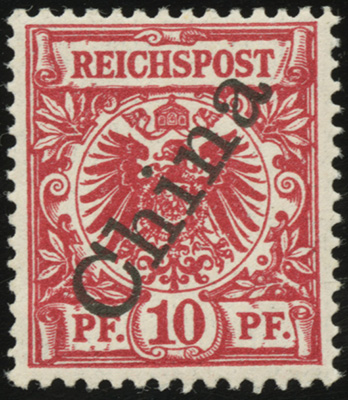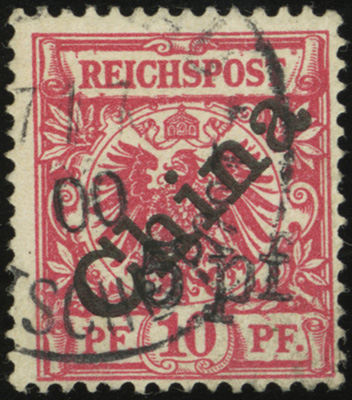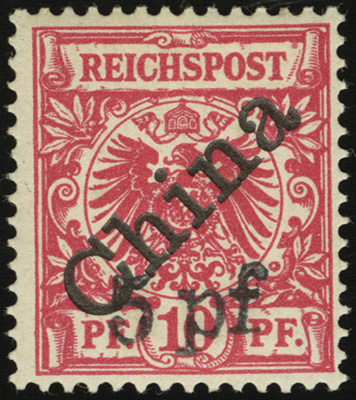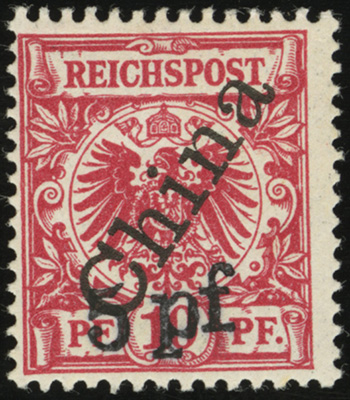German Offices in China Futschau Provisionals
Nov 30, 2020 0:18:03 GMT -5
kacyds, Philatarium, and 5 more like this
Post by PostmasterGS on Nov 30, 2020 0:18:03 GMT -5
I received the final stamp of this set today, so here's another rare set from the German offices in China — the Futschau Provisionals.
During the Boxer Rebellion, there was a great shortage of postage at the German post offices in China. To remedy this shortage, German and Kiautschou postage was used in a variety of provisional forms. Among these were the Futschau Provisionals.
Soon after opening the Futschau post office on 19 June 1900, the post office ran out of 5 Pfennig stamps.

German PO in China 5 Pf stamp
To remedy the shortage, the postmaster ordered wood type from a Chinese print shop, which was made into a '5 pf' handstamp.
At the time, the German Offices in China were using two types of 'China' overprint stamps — 45° and 56° overprints. The first provisional printing, on 7 July 1900, consisted of handstamped overprints of the 10 Pfenning values — 1,400 copies of the 56° stamp and 100 copies of the 45° stamp.
To satisfy the heavy demand by collectors, a second handstamping of 2,500 copies of the 45° stamp was made on 7 November 1900.
Thus, three varieties exist:
MiNr. 7 I A — the first batch (100) of handstamps on the 45° stamps
MiNr. 7 I B — the second batch (2,500) of handstamps on the 45° stamps
MiNr. 7 II — the only batch (1,400) of handstamps on the 56° stamps

MiNr. 7 I A — 45° Overprint (7 Jul-6 Nov 1900)

MiNr. 7 I B — 45° Overprint (7 Nov 1900 on)

MiNr. 7 II — 56° Overprint

The Album Page
The first and second batches of handstamps on the 45° stamps (MiNr. 7 I A and 7 I B) can be distinguished only by their cancel dates, with cancels of 6 November 1900 and earlier being the rare first printing. All unused copies of the 45° stamps are presumed to be from the second printing.
The respective Michel values are illustrative of their rarity, though oddly enough, the values for MiNr 7 I B and MiNr. 7 II are the reverse of what you might expect based on the number printed (IOW, MiNr. 7 II has a lower CV, despite being numerically rarer than MiNr. 7 I B).

Also, note that the Futschau Provisional is very similar to appearance in a couple Kiautschou Provisionals that also had 5 Pfennig handstamps on the 'China' 10 Pfennig stamps (more on these later). The handstamps can be distinguished by the following:
China Futschau Provisional — '5 pf'
Kiautschou 1st Tsingtau Provisional — '5 Pfg.'
Kiautschou 2nd Tsingtau Provisional — '5 Pf.'
During the Boxer Rebellion, there was a great shortage of postage at the German post offices in China. To remedy this shortage, German and Kiautschou postage was used in a variety of provisional forms. Among these were the Futschau Provisionals.
Soon after opening the Futschau post office on 19 June 1900, the post office ran out of 5 Pfennig stamps.

German PO in China 5 Pf stamp
To remedy the shortage, the postmaster ordered wood type from a Chinese print shop, which was made into a '5 pf' handstamp.
At the time, the German Offices in China were using two types of 'China' overprint stamps — 45° and 56° overprints. The first provisional printing, on 7 July 1900, consisted of handstamped overprints of the 10 Pfenning values — 1,400 copies of the 56° stamp and 100 copies of the 45° stamp.
To satisfy the heavy demand by collectors, a second handstamping of 2,500 copies of the 45° stamp was made on 7 November 1900.
Thus, three varieties exist:
MiNr. 7 I A — the first batch (100) of handstamps on the 45° stamps
MiNr. 7 I B — the second batch (2,500) of handstamps on the 45° stamps
MiNr. 7 II — the only batch (1,400) of handstamps on the 56° stamps

MiNr. 7 I A — 45° Overprint (7 Jul-6 Nov 1900)

MiNr. 7 I B — 45° Overprint (7 Nov 1900 on)

MiNr. 7 II — 56° Overprint

The Album Page
The first and second batches of handstamps on the 45° stamps (MiNr. 7 I A and 7 I B) can be distinguished only by their cancel dates, with cancels of 6 November 1900 and earlier being the rare first printing. All unused copies of the 45° stamps are presumed to be from the second printing.
The respective Michel values are illustrative of their rarity, though oddly enough, the values for MiNr 7 I B and MiNr. 7 II are the reverse of what you might expect based on the number printed (IOW, MiNr. 7 II has a lower CV, despite being numerically rarer than MiNr. 7 I B).

Also, note that the Futschau Provisional is very similar to appearance in a couple Kiautschou Provisionals that also had 5 Pfennig handstamps on the 'China' 10 Pfennig stamps (more on these later). The handstamps can be distinguished by the following:
China Futschau Provisional — '5 pf'
Kiautschou 1st Tsingtau Provisional — '5 Pfg.'
Kiautschou 2nd Tsingtau Provisional — '5 Pf.'




